Table of Contents
Transom windows can significantly improve your home’s energy efficiency, particularly when they come with high-quality insulation and proper sealing. Featuring double or triple-glazed glass along with low-emissivity coatings, these windows effectively minimize heat transfer and reduce energy loss. Additionally, they allow natural light to enter your home, which can help lower your electricity bills by decreasing the need for artificial lighting.
To further enhance efficiency and comfort, proper weather stripping and caulking can help prevent drafts. Investing in well-designed transom windows not only adds visual appeal but can also boost your home’s market value. If you’re interested, there’s a lot more to discover about their benefits and installation.
Understanding Transom Windows
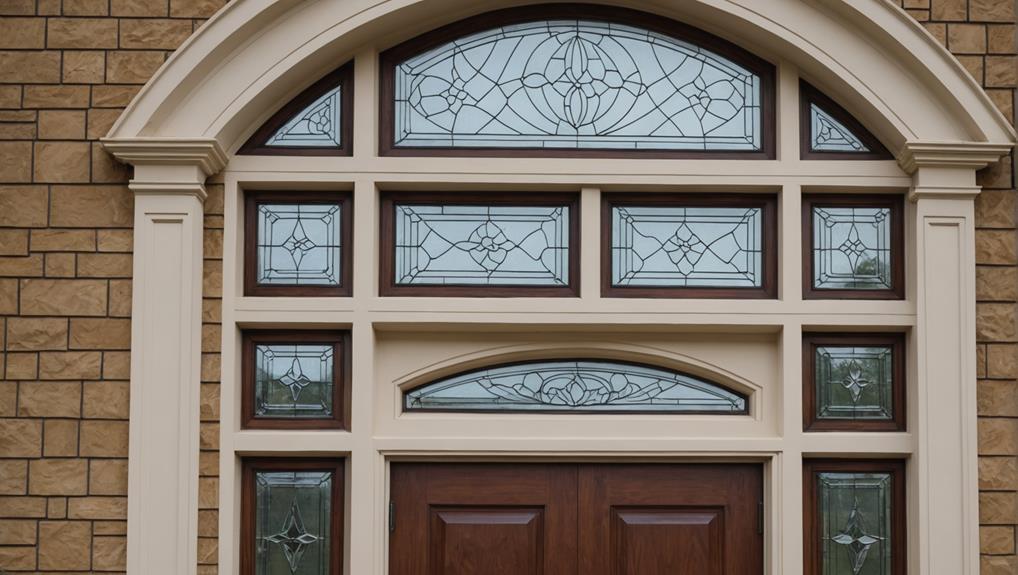
Transom windows are often overlooked features that can enhance both natural light and architectural appeal in your home. These elegant additions have a rich transom window history, dating back to ancient Roman architecture. They were initially designed to allow light and air into spaces while maintaining privacy. As architectural styles evolved, transom windows became popular in various designs, from classic Victorian homes to modern minimalist structures.
When you consider incorporating transom windows, think about how they can complement your home’s existing architectural style. Whether your space leans toward traditional or contemporary, transoms can serve as a striking design element. You’ll notice that they come in various shapes and sizes, allowing for customization that perfectly fits your aesthetic needs.
Moreover, transom windows can create a sense of openness in your home. By strategically placing them above doors or larger windows, you can maximize natural light without sacrificing wall space.
Thermal Performance Characteristics
When you’re considering transom windows, understanding their thermal performance characteristics is essential.
You’ll want to look into insulation properties, the types of glass used, and how air leakage can affect energy efficiency.
These factors play a significant role in maintaining a comfortable indoor environment and reducing energy costs.
Insulation Properties Explained
Understanding the insulation properties of transom windows can greatly enhance your home’s energy efficiency. When you choose high-quality transom windows, you’ll notice a significant difference in how well your home retains heat in winter and stays cool in summer. The effectiveness of these windows largely depends on the insulation materials used in their construction.
Transom windows often utilize advanced insulation materials that minimize heat transfer. By incorporating materials like low-conductivity foam or insulated frames, these windows help maintain a stable indoor temperature, which means your heating and cooling systems won’t have to work as hard. This leads to lower energy bills and a more comfortable living environment.
Additionally, proper sealing around transom windows is essential for maximizing insulation. Gaps or leaks can undermine the effectiveness of even the best insulation materials, allowing drafts that waste energy. By ensuring your transom windows are well-installed and properly sealed, you’ll boost their insulation properties.
Investing in transom windows with superior insulation not only enhances energy efficiency but also contributes to a more sustainable home. So, consider these factors when choosing windows for your next project.
Glass Types Impact
The type of glass you choose for your transom windows considerably affects their thermal performance characteristics and overall energy efficiency. Selecting the right glass can make a significant difference in how well your windows retain heat during winter and reflect it during summer.
For instance, low-emissivity (Low-E) glass coatings help reduce energy loss by reflecting infrared light while allowing visible light to enter. This means you’ll enjoy natural light without sacrificing comfort.
Additionally, the frame materials you pair with your glass can impact energy efficiency. For example, frames made from vinyl or fiberglass typically provide better insulation than aluminum frames, which can conduct heat and cold.
Choosing double or triple-glazed windows enhances thermal performance by creating air or gas-filled spaces between the panes, further minimizing heat transfer.
Consider also how the glass coatings interact with your specific frame materials to maximize energy efficiency. If you opt for high-performance glass but pair it with a less efficient frame, you mightn’t achieve the energy savings you desire.
Air Leakage Considerations
Air leakage can greatly impact your transom windows’ thermal performance, so it’s vital to guarantee a proper seal around the frame. Poor air sealing may result in drafts, increased energy bills, and discomfort in your home.
To enhance the energy efficiency of your transom windows, consider the following strategies:
- Inspect Seals Regularly: Check the seals around your transom windows for any gaps or deterioration. A tight seal is fundamental for preventing air leakage.
- Install Weather Stripping: Adding weather stripping can markedly reduce air infiltration. Choose high-quality materials that can withstand the elements over time.
- Use Caulk Wisely: Applying caulk to gaps and cracks can enhance your air sealing efforts. Make sure to select a caulk suitable for exterior use, as it needs to endure temperature fluctuations and moisture.
Natural Light Benefits
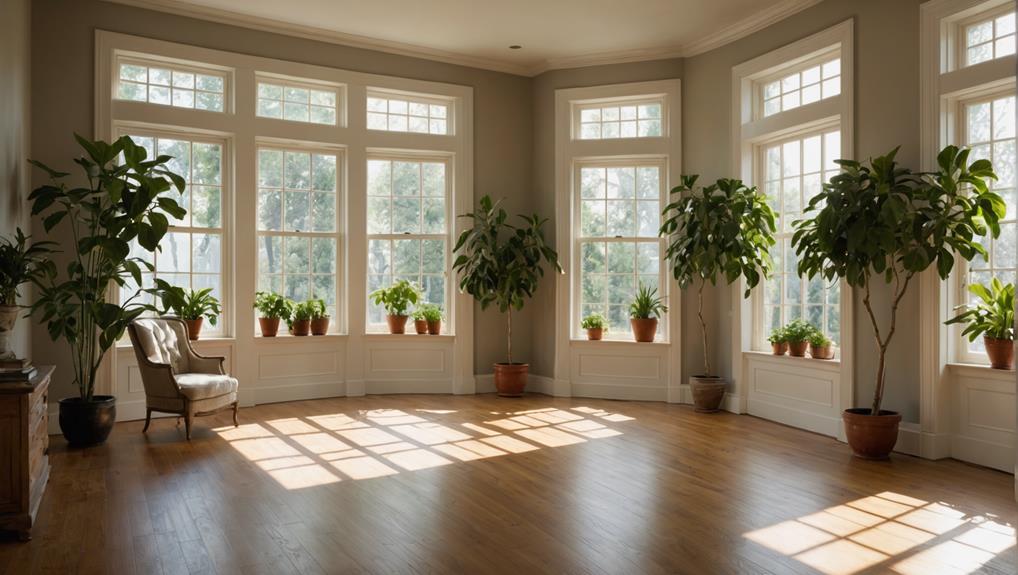
When you install transom windows, you’re not just adding a stylish touch; you’re also boosting the natural light in your space.
This enhanced daylight infiltration means you’ll rely less on artificial lighting, cutting down on energy costs.
Embracing natural light can transform your environment, making it feel more open and inviting.
Enhanced Daylight Infiltration
Transom windows let in abundant natural light, transforming spaces and boosting your mood. With their strategic placement above doors or larger windows, they enhance daylight distribution, creating a bright and inviting atmosphere. Not only do they illuminate areas that might otherwise feel dark, but they also provide aesthetic enhancement, giving your home a touch of elegance.
Here are three key benefits of enhanced daylight infiltration:
- Improved Ambiance: Natural light creates a warm and welcoming environment that can make any room feel more spacious.
- Health Benefits: Exposure to natural light can improve your mood, increase energy levels, and even help regulate your sleep cycle.
- Visual Appeal: Transom windows can serve as stunning design elements, adding character and style to your home while optimizing the flow of light.
Incorporating transom windows into your space not only maximizes natural light but also enhances your overall living experience.
Reduced Artificial Lighting Needs
By maximizing natural light, transom windows greatly cut down your reliance on artificial lighting, leading to lower energy consumption and reduced electricity bills. With more sunlight streaming into your space, you’ll enjoy higher light quality, which can positively impact your mood and productivity. Natural light creates a warm, inviting atmosphere that artificial lights often struggle to replicate.
You might also notice that the aesthetic appeal of your rooms improves considerably. Transom windows can enhance architectural design while allowing sunlight to brighten corners that might otherwise remain dim. This not only reduces the need for electric lights during the day but also makes your home feel more open and spacious.
When you depend less on artificial lighting, you’re not just saving money; you’re also contributing to a more sustainable living environment. You’ll appreciate how the combination of beauty and functionality in transom windows enriches your daily life.
Plus, the added daylight can help alleviate the tendency to feel sluggish, making your home a more enjoyable place to be. Embracing natural light with transom windows is a smart move for both your wallet and your well-being.
Ventilation and Airflow
Effective ventilation and airflow are essential for maintaining a comfortable indoor environment, and transom windows play a key role in enhancing both. By allowing warm air to escape and cooler air to enter, these windows can greatly improve airflow dynamics in your space.
Here are three ways transom windows contribute to effective ventilation strategies:
- Natural Ventilation: Transom windows can be easily opened to promote cross-ventilation, allowing fresh air to circulate throughout your home. This reduces reliance on mechanical systems, saving energy.
- Heat Dissipation: By positioning transom windows above doors or larger windows, you can help hot air escape, especially in warmer months. This upward movement of air creates a natural flow that keeps your indoor environment cooler.
- Enhanced Light and Airflow: Transom windows can be strategically placed to maximize both natural light and airflow. This combination not only brightens your space but also encourages better air exchange, improving indoor air quality.
Insulation Properties
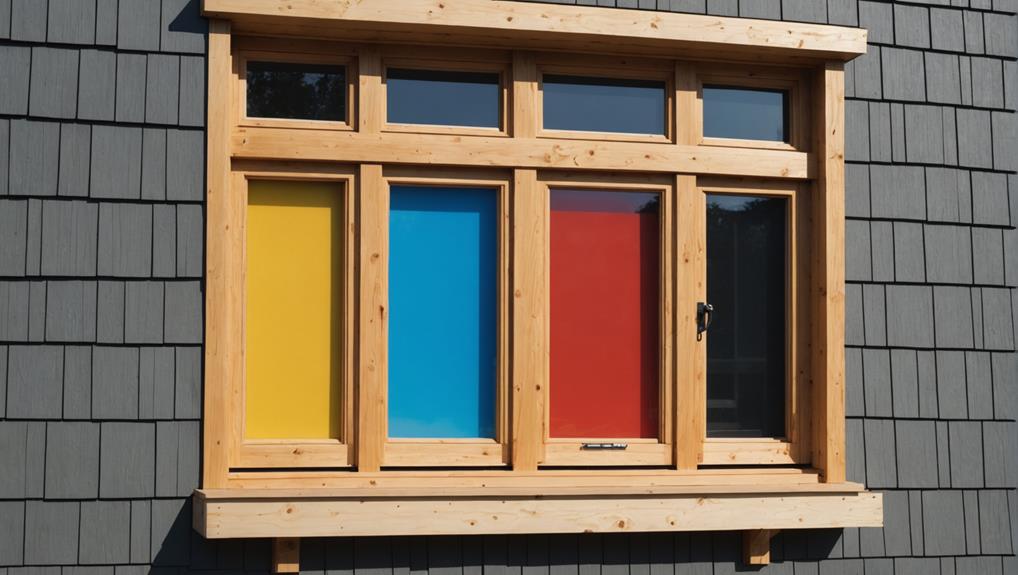
Insulation properties of transom windows can greatly enhance your home’s energy efficiency, reducing heat loss in winter and keeping interiors cooler in summer. When you choose high-quality transom windows, pay attention to the insulation materials used in their construction.
These materials, such as double or triple glazing, low-emissivity (Low-E) coatings, and argon gas fills, considerably boost the window’s insulating capabilities.
You should also consider the energy ratings of the windows. Look for products with good U-values and Solar Heat Gain Coefficients (SHGC), as these metrics indicate how well the windows resist heat flow and manage solar heat.
A lower U-value means better insulation, while an appropriate SHGC ensures you’re not letting in unnecessary heat during warmer months.
Energy Cost Savings
How much could you save on energy bills by installing energy-efficient transom windows? The answer lies in effective energy budgeting and a thorough cost analysis. By incorporating these windows into your home, you can greatly reduce your heating and cooling expenses.
Here are three key areas where you may notice savings:
- Reduced Energy Loss: Energy-efficient transom windows minimize heat transfer, keeping your home warmer in winter and cooler in summer. This means your HVAC system won’t have to work as hard, leading to lower energy bills.
- Natural Light Utilization: These windows allow more natural light into your home, reducing the need for artificial lighting. The less you rely on electric lights, the more you can save on your energy costs.
- Long-Term Durability: Investing in quality transom windows can yield long-term savings. They’re designed to last, reducing the need for frequent replacements and the associated costs.
Incorporating transom windows not only enhances your home’s beauty but also aligns with smart energy budgeting, ultimately leading to lower expenses and a more comfortable living environment.
Impact on Home Value
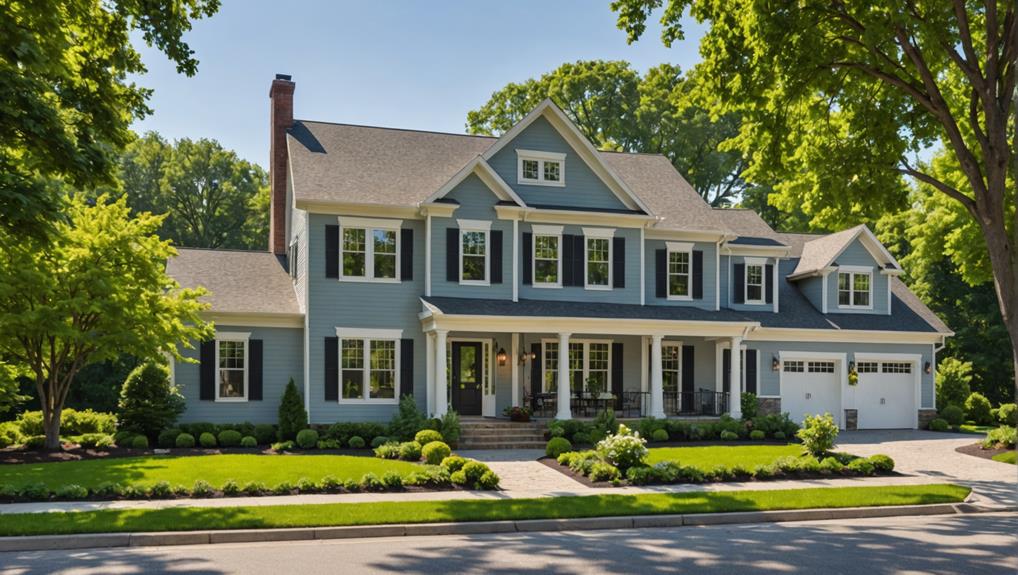
Installing energy-efficient transom windows can greatly boost your home’s market value by enhancing its aesthetic appeal and energy performance.
When potential buyers walk into a home, they often notice details like transom windows that add character and charm. These windows not only provide natural light but also create a welcoming atmosphere, making your home more inviting.
In today’s competitive real estate market, features that highlight energy efficiency can considerably impact home resale value. Buyers are increasingly looking for homes that offer lower energy costs and sustainable features.
By installing transom windows that meet energy-efficient standards, you’re likely to attract more interest and potentially higher offers.
Moreover, homes with visually appealing windows often stand out in listings and showings, further increasing their desirability. This added aesthetic appeal can lead to quicker sales and leverage higher price points when it comes time for you to sell.
Sustainable Design Considerations
Energy-efficient transom windows not only elevate your home’s appeal and value but also play a significant role in sustainable design practices that minimize environmental impact. By incorporating these windows into your home, you can actively contribute to a greener future.
Here are three considerations to keep in mind:
- Eco-Friendly Materials: Opt for transom windows made from eco-friendly materials, such as recycled aluminum or sustainably sourced wood. These materials reduce waste and lower your carbon footprint.
- Passive Design: Utilize the principles of passive design by strategically placing transom windows to maximize natural light and ventilation. This reduces reliance on artificial lighting and air conditioning, leading to lower energy consumption.
- Energy Ratings: Look for windows with high energy efficiency ratings, such as ENERGY STAR certification. These windows are designed to provide superior insulation, keeping your home comfortable while minimizing energy costs.

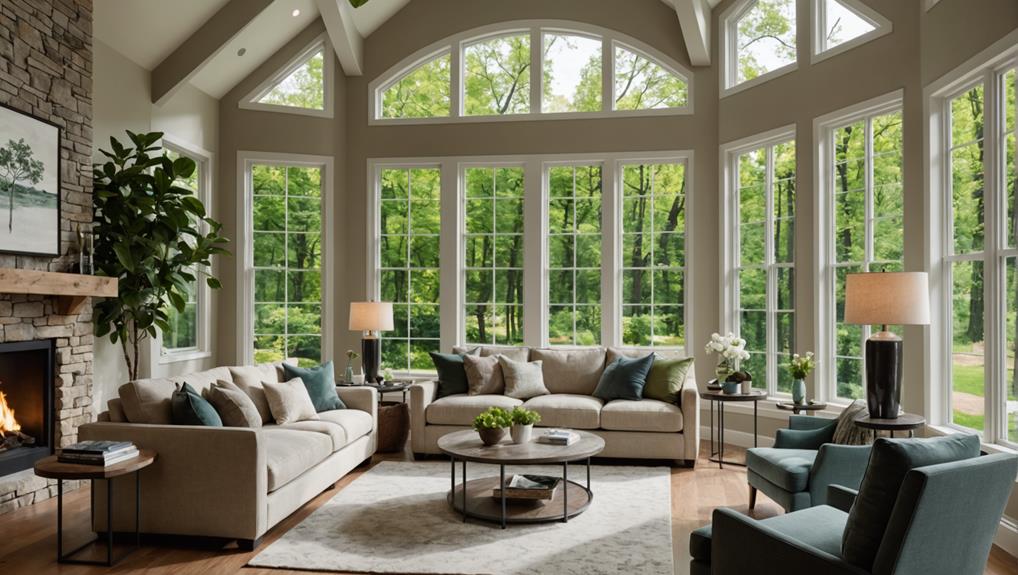
Leave a Reply